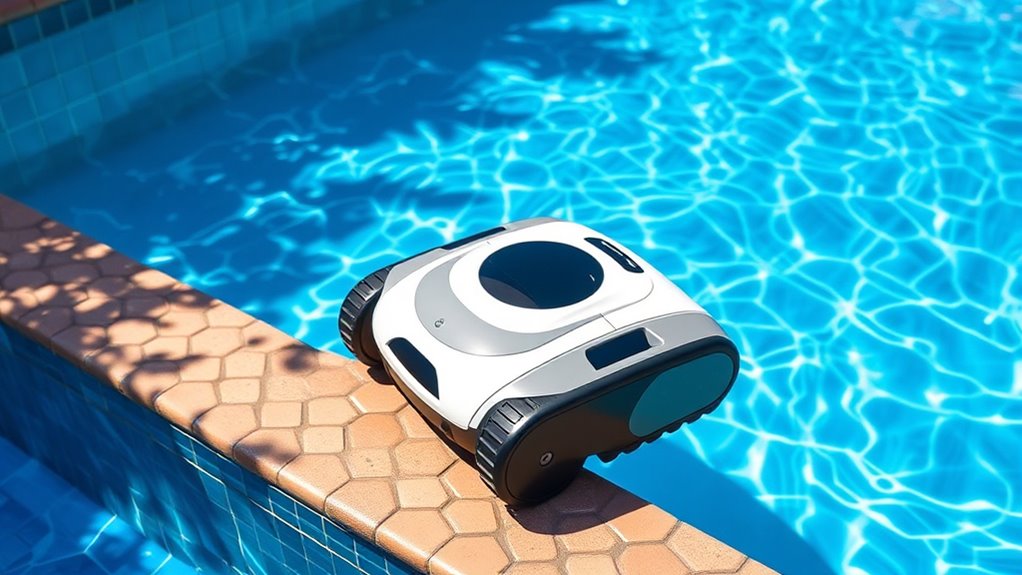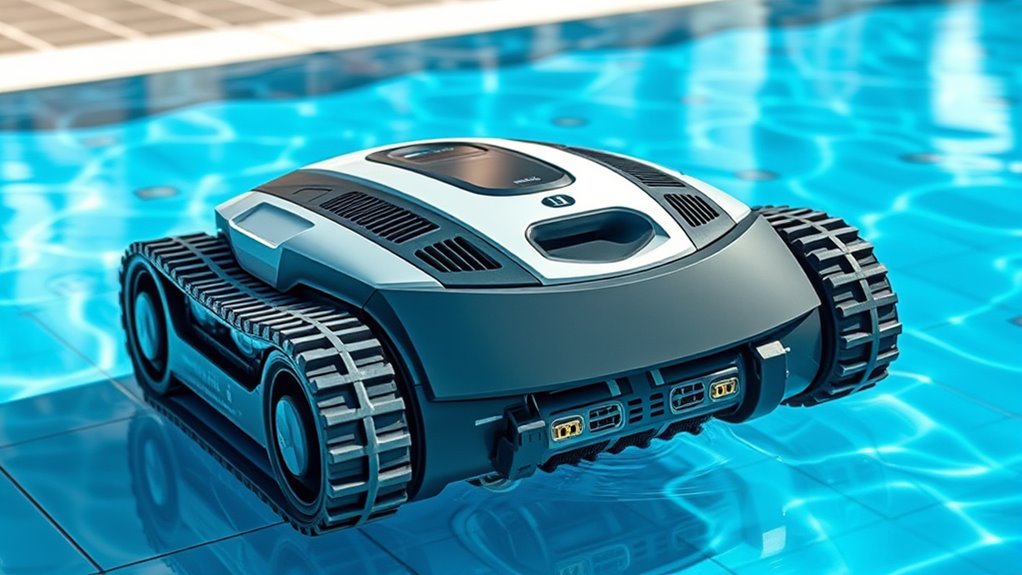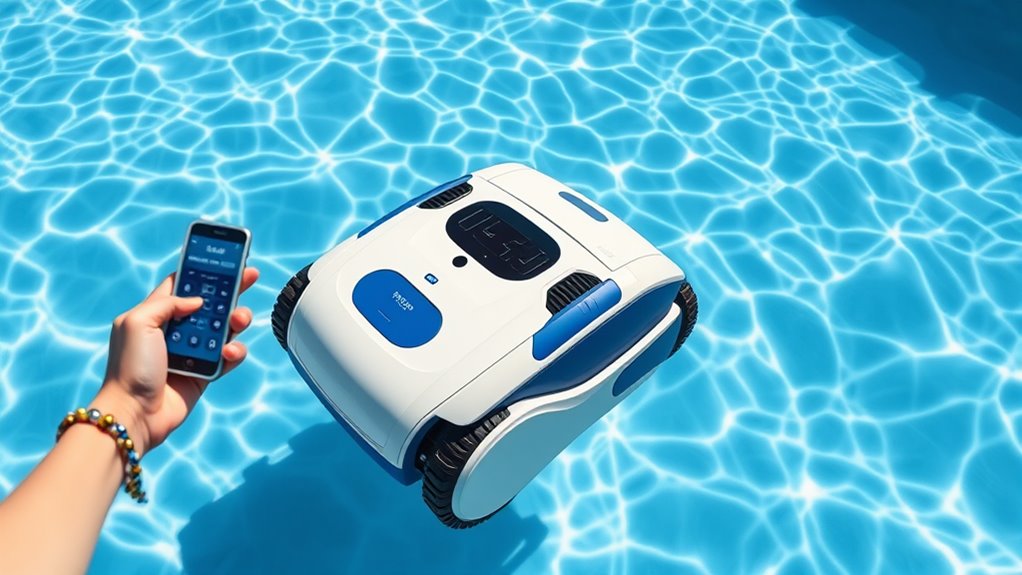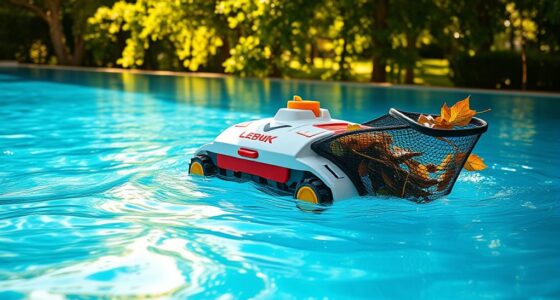When choosing a robotic pool cleaner, focus on whether it fits your pool’s size and shape, making sure it covers all areas efficiently. Look at its cleaning features, like filter types and navigation abilities, to match your surface and debris needs. Check its battery life and charging options for reliable use, and consider your budget for long-term costs like maintenance or replacements. Want to guarantee ease of use and durability? Keep exploring for helpful tips and details.
Key Takeaways
- Match the cleaner’s size, shape, and surface compatibility to your pool for effective cleaning.
- Choose features like advanced programming, wall-climbing ability, and debris filters based on your cleaning needs.
- Ensure battery life and charging options align with your pool size for continuous operation.
- Consider long-term costs, including energy efficiency, warranties, and maintenance expenses.
- Opt for user-friendly models with easy maintenance, remote control, and noise levels suitable for your environment.
Compatibility With Your Pool Size and Shape

Choosing a robotic pool cleaner that matches your pool’s size and shape is essential for effective cleaning. The cleaner’s design should suit your pool surface, whether it’s a smooth concrete, vinyl, or fibreglass. Larger pools require a model with longer battery life and bigger coverage capacity, while smaller pools benefit from compact, agile units. Consider the pool material as well; rough surfaces like exposed aggregate may need a cleaner with stronger brushes or scrubbing features. Shape matters too—an irregularly shaped pool might require a model with advanced navigation to reach all corners. Additionally, self-watering features in some models can help maintain optimal operation by preventing overuse of the motor. These features can also contribute to the overall energy efficiency of the cleaning process. By selecting a compatible cleaner, you guarantee thorough cleaning without wasting time or energy, keeping your pool pristine and ready for use.
Cleaning Capabilities and Features

When evaluating robotic pool cleaners, it’s important to take into account their cleaning capabilities and features to guarantee they meet your specific needs. Consider the filter types, such as cartridge, sand, or multi-layer filters, which determine how well the cleaner captures debris and dirt. Look for models with advanced programming options that allow you to set cleaning schedules, customize cleaning zones, or select specific cleaning modes. These features help optimize performance and save time. Additionally, check if the cleaner can target different surfaces like tiles, vinyl, or concrete, and if it can handle debris of various sizes. A model with versatile cleaning capabilities and flexible programming options ensures thorough cleaning and convenience, making your pool maintenance easier and more efficient. Properly assessing vacuum cleaner performance metrics can also help you choose a model that offers reliable suction power and filtration efficiency. Moreover, understanding the technology integrations can provide insights into how modern features enhance overall cleaning performance and user experience. Considering wall-climbing abilities can further improve the cleaner’s effectiveness in reaching all areas of the pool, ensuring comprehensive cleaning coverage. Additionally, paying attention to noise levels can help select a model that operates quietly, reducing disruptions during use. For optimal results, selecting a model with HEPA-like filters can significantly improve the removal of fine particles and allergens from your pool environment.
Battery Life and Charging Requirements

Battery life and charging requirements are crucial factors to evaluate because they directly impact how long your robotic pool cleaner can operate and how convenient it is to use. Check the battery capacity to confirm it can handle your pool’s size without frequent recharges. A higher battery capacity means longer cleaning sessions and fewer interruptions. Additionally, consider the charging station; some models require a dedicated dock where the robot automatically recharges. Look for a model with a quick-charging feature if you want minimal downtime. Keep in mind that a longer battery life paired with an efficient charging station makes your cleaning routine smoother and more reliable. Monitoring the battery health and performance longevity can help you maintain optimal performance over time. Regular maintenance and proper storage can also extend the overall lifespan of the battery, ensuring consistent cleaning power. Choosing the right combination ensures your pool stays clean with less effort on your part.
Budget and Long-Term Cost of Ownership

Considering the battery life and charging needs helps you evaluate the ongoing costs of owning a robotic pool cleaner. Beyond initial purchase, you should assess long-term expenses such as energy efficiency and warranty coverage. For example, a model with higher energy efficiency can reduce electricity bills over time. Additionally, a detailed warranty can save you repair costs if parts or the motor fail prematurely. Think about these factors: 1. Energy consumption during regular use 2. Frequency of battery replacements or upgrades 3. Scope of warranty coverage for parts and labor 4. Potential costs for professional repairs outside warranty. Monitoring maintenance requirements can help prevent unexpected breakdowns and extend the lifespan of your device. Regularly inspecting your cleaner and performing simple preventive maintenance tasks can further reduce the likelihood of unexpected issues. Proper equipment handling and adherence to recommended practices can also contribute to the overall durability of your robotic cleaner. Maintenance practices that include cleaning brushes and filters are essential for optimal performance. Balancing these costs ensures you choose a cleaner that fits your budget and minimizes long-term ownership expenses. This approach helps you avoid surprises and makes your investment more cost-effective.
Maintenance and Ease of Use

Maintaining your robotic pool cleaner is straightforward if you follow a few simple steps, making it easy to keep it running smoothly. Regularly clean the filter and brush to prevent clogs and sustain peak performance. Many models come with a remote control, allowing you to start or stop cleaning sessions conveniently, which enhances ease of use. Also, check the cables and wheels for wear and tear to guarantee smooth operation over time. Noise levels can vary between models; quieter units are less disruptive, especially if you plan to run the cleaner during peak hours. Additionally, understanding the importance of proper maintenance routines can prolong your device’s lifespan and ensure optimal cleaning results. Proper storage practices when the device is not in use help prevent damage from environmental factors and extend its life. Regular inspections and following the manufacturer’s guidelines help prevent issues and improve overall performance. Being aware of filter replacement schedules and techniques can further optimize cleaning efficiency and avoid unnecessary repairs. By staying on top of routine maintenance and choosing a model with user-friendly features, you’ll enjoy hassle-free cleaning and longer-lasting performance.
Frequently Asked Questions
Can Robotic Pool Cleaners Handle Pools With Complex or Irregular Shapes?
Robotic pool cleaners can handle pools with complex or irregular shapes, but your choice matters. Look for models designed for pool shape challenges, as they feature advanced navigation and flexible brushes. These cleaners excel at irregular surface cleaning by adapting to corners, steps, and uneven surfaces. With the right model, you’ll enjoy thorough cleaning even in intricate pools, saving you time and effort while maintaining a pristine swimming environment.
Are Robotic Cleaners Suitable for Pools With Variable Water Levels?
Ever notice how some robotic cleaners seem to adapt unexpectedly? They often handle variable water levels and pool depth variations with ease, thanks to smart navigation systems. You’ll find that many models adjust to changing water levels, maintaining effective cleaning. So, if your pool’s water fluctuates or has depth differences, a robotic cleaner can still do a great job, making your maintenance simpler and more efficient.
Do Robotic Pool Cleaners Work Effectively on All Pool Surface Types?
Robotic pool cleaners are generally effective on most surface types, but cleaning efficiency varies depending on surface compatibility. You’ll find they work well on smooth surfaces like tile and plaster, but may struggle with rough or textured surfaces. To guarantee ideal cleaning, check the product’s specifications for surface compatibility. By choosing a model suited for your pool’s surface, you’ll maximize cleaning efficiency and keep your pool sparkling clean.
How Do I Troubleshoot if My Robotic Cleaner Gets Stuck or Doesn’T Operate?
Ever feel like your robotic pool cleaner has a mind of its own? When it gets stuck or won’t run, don’t just panic—try manual maintenance first. Check for tangled cords or obstacles blocking its path. Use troubleshooting tips like cleaning filters and resetting the device. Sometimes, a simple restart or removing debris does the trick. With patience, you’ll keep your pool spotless without calling in a pro.
Are There Safety Features to Prevent Damage or Injury During Operation?
Robotic pool cleaners come with safety mechanisms like sensors that detect obstacles or potential hazards, preventing damage or injury. Many models feature an emergency shutoff, so if something goes wrong, you can stop it immediately. These safety features guarantee smooth operation and safeguard you and your pool. Always check for these safety mechanisms when choosing a cleaner, so you enjoy safe, hassle-free pool maintenance.
Conclusion
Choosing the right robotic pool cleaner isn’t just about price—it’s about matching features to your pool’s needs. Picture it like fitting a puzzle piece: if you pick one too small or too big, it won’t work well. By considering size, features, battery life, costs, and maintenance, you make certain of a smooth experience. Think of it as investing in a reliable partner that keeps your pool pristine, saving you time and effort in the long run.









